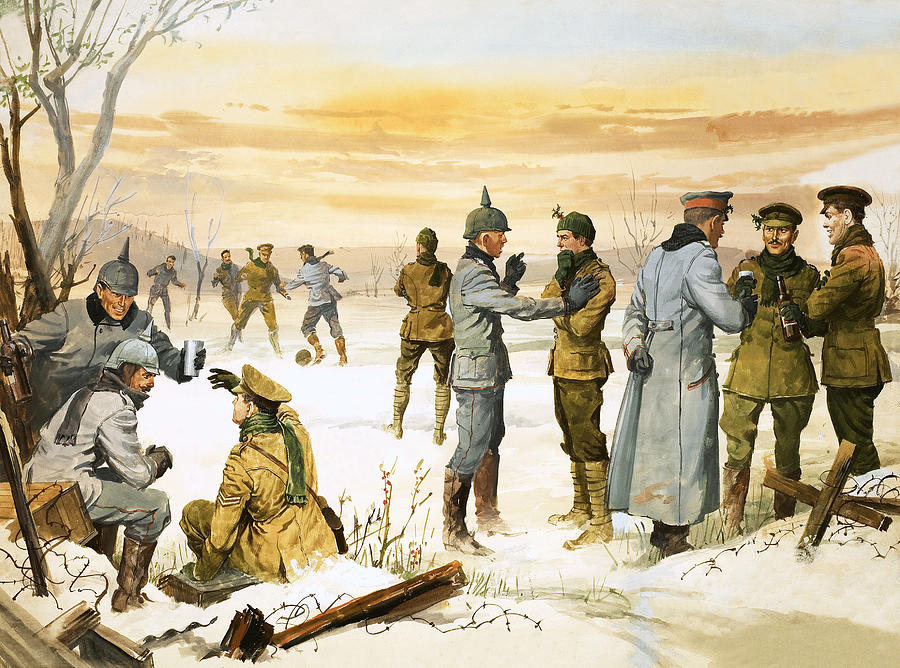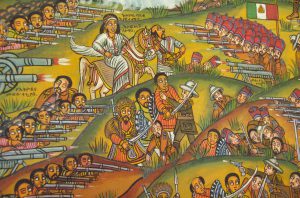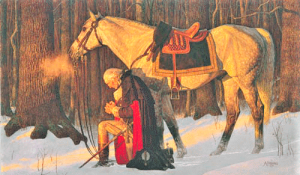The chilling cold was inescapable and constant along the trenches. This was only worsened by the rain-water flooding the muddy walls and floors. Some months had passed since the beginning of World War I, and it was now December of the year 1914. Being “home by Christmas” was out of the question, and a seemingly insuperable stalemate had been reached along the trenches stretching from the Alps to the English channel. The area between these trenches is what was known as “No Man’s Land.” This name was not a novelty in history, but it certainly increased in accuracy since its first usage. Soldiers, young men sometimes as young as fifteen, were dying by the thousands, killed by the indiscriminate fire of the machine gun, a recent addition to the arsenal of armies.1
The Allied Forces had just held off the invading German army along the Marne river, in what was called the “Miracle of the Marne.” The allied victory here signified the failure of the “Schlieffen Plan,” Germany’s attempt at sweeping a 180-degree rotation through neighboring Belgium and France. This strategy would require German troops to rapidly defeat French forces, so that they could be speedily transported via train to what would be the Eastern Front, where Russia would hopefully be slow to mobilize.2

The first trenches were dug on the western front immediately after the Battle of the Marne, which ended on September 12, 1914. The trenches were dug to survive the incoming attacks more easily. However, these trenches would later mark the border into a place of almost certain death.3 The battles of Verdun, the Somme, the Hundred Day Offensive, and Spring Offensive, fought on the Western Front, ended the lives of 5.5 million men. Sixty thousand British soldiers died on the first day of the Battle of the Somme, a death-count still unparalleled in British military history.4
The time in between battles in the trenches was miserable. The 700-kilometer system of parallel trenches was infested with rats, lice, and the bodies of dead horses and men, whom they would stop burying, because the count was so high and because they simply could not reach the bodies without a high risk of losing their own lives in the process. Crosses scattered around the trenches marked the resting places of fallen men, and also provided a grim reminder of the brutality they faced. These insane living conditions led to death by diseases such as dysentery, typhus, or cholera. This place could easily be likened to Hell on Earth. The area between trenches supported this description, a wasteland of barbed wire and tree trunks with no branches.5 Day and night, this is what the men at the front would experience. In fact, the German Expressionist Otto Dix described the trenches eloquently:
“Lice, rats, barbed wire, fleas, shells, bombs, underground caves, corpses, blood, liquor, mice, cats, artillery, filth, bullets, mortars, fire, steel: That is what war is. It is the work of the devil.”6
But then came December. A different feeling was noticeable and written about by the men in the trenches. Sniping had grown rarer, and both French and British soldiers could occasionally hear sentimental singing from the German trenches. Naturally the higher ups thought this to be some sort of tactic by the Germans. Lit up trees would appear, and shortly after, singing would ensue. The French and British soldiers were baffled, because Germans were supposed to be “barbarians.” The Christmas trees that would appear in the not so distant German trenches were somewhat of a novelty to French and British soldiers. However, they were part and parcel of the German Christmas that year.7 Some of the British soldiers shot at the Christmas trees at first, not knowing what to expect. Imagine that after shooting several times at targets near the Germans, they start calling out, promising not to shoot. After months at war, this would not make any sense to war-hardened soldiers.8
A literal calm came on the 4th of December, when an absence of gunfire was reported in some locations. The next day, a royal engineer by the name of Andrew Todd wrote to the Edinburgh Scotsman that soldiers were being “pally” with the enemy. He described their interactions, which included playful cursing at each other, and tossing newspapers from one side to the other, in places separated by only sixty yards. In a card to his mother, one rifleman wrote about how the Germans had peacefully come up and collected some of their wounded, and the British quickly went and collected their own, and after talking, both sides decided to help in burying each other’s dead. The rifleman went on to describe the enemy soldiers as “fine men.” These interactions only increased the closer they got to Christmas. By December 20, both Allied forces and Germans were intent on celebrating Christmas. In preparation of a gift exchange, British forces prepared to give brass boxes, which had been given to them by the crown. These boxes contained cigarettes and pipe tobacco, as well as a greeting card that read “May God protect and bring you home safe.” The Germans, on the other hand, provided some musical entertainment, cigars, and beer imported from as far away as Munich. In a semi-official report, Major Jeffreys provided a description of “A Christmas Onslaught onto the Field-Grey (troops)” as follows:
“Yesterday about Four-o’clock in the afternoon there was a fierce and terrible onslaught of Christmas packages onto our trenches. No man was spared. However, not a single package fell into the hands of the French. In the confusion, one soldier suffered the impaling of a salami two inches in diameter straight into his stomach…. Another had two large raisins from an exploding pastry fly directly into his eyes…. A third man had the great misfortune of having a full bottle of cognac fly into his mouth.”9
Enemies were “fraternizing” with each other. Men who had been killing each other the previous four months, living in disease-riddled trenches, were singing together, playing soccer, getting drunk, throwing down their guns and smoking a cigar or two.10 The Brits sang ‘cheeky’ songs, eventually followed by Christmas carols, and “God save the King,” and the Germans sometimes sang too, accompanied by musical instruments.11 Christmas trees adorned the trenches, and a true spirit of Christmas had possessed these men, a true miracle really.
But the year was 1914, and the war would last until 1918. The continuation of the war would eventually return, because of people like Captain Rudolf Binding, a Hussar who in a letter complained to his father that if he were in power, Christmas would be banned for the year. Measures taken to resume the war, included the banning of future fraternizations with the enemy and an increased pressure on generals to end the peace, in some cases by making the men believe that the truce was part of a nefarious plan by the enemy. This eventually led to more killing, however, in a less eager manner.12 Upon the setting of the sun on Christmas day, one soldier in St. Yvon, twenty-six-year-old Lieutenant Charles Bruce Bairnsfather described a feeling that “It was just the sort of day for peace to be declared.” He talked about wishing that a telegraph boy would reach him with a letter from the King telling the troops that the war is off, and to go back home.13 That day did not come soon.
It is important to note that this truce was informal, and did not only include a single truce but several throughout the trenches. It is said that one similar, yet much less enthusiastic truce was struck in 1915. However, by that time, the propaganda on the barbarity of the Germans had been spread more aggressively.14 There was peace, but not only peace. In one of the most inhumane wars in history, individual men crossed the place called “No man’s land” and shook their enemy’s hand. They complained about the damn war, and wished each other a Merry Christmas.

- Stanley Weintraub, Silent Night (Free Press, 2001), 9; John Keenan, An Illustrated History of the First World War (Alfred A Knopf, 2001), 170. ↵
- Terrence M. Holmes, Absolute Numbers: The Schlieffen Plan as a Critique of German Strategy in 1914 (Sage Publications, Ltd. 2014), 197-199. ↵
- John Keenan, An Illustrated History of the First World War (Alfred A Knopf, 2001), 180. ↵
- The Oxford Companion to British History, 3 Apr. 2018, s.v. “Somme, Battle of the,” by David French. ↵
- Jay Winter, The Legacy of the Great War-Ninety Years On (University of Missouri Press), 26-27. ↵
- Stanley Weintraub, Silent Night (The Free Press 2001), 2. ↵
- Modris Eksteins, Rites of Spring (New York: Houghton Mifflin Harcourt, 2000), 110-111. ↵
- Kathryn N. McDaniel, Commemorating the Christmas Truce: A Critical Thinking Approach for Popular History (Society for History Education), 92. ↵
- Stanley Weintraub, Silent Night (Free Press, 2001), 11. ↵
- Stanley Weintraub, Silent Night (Free Press, 2001), 9. ↵
- Kathryn N. McDaniel, Commemorating the Christmas Truce: A Critical Thinking Approach for Popular History (Society for History Education), 92. ↵
- Michael S. Neiberg, Fighting the Great War- A Global History (Harvard University Press, 2006), 70. ↵
- Stanley Weintraub, Silent Night (The Free Press, 2001), 16. ↵
- Kathryn N. McDaniel, Commemorating the Christmas Truce: A Critical Thinking Approach for Popular History (Society for History Education), 92-91. ↵



126 comments
Honoka Sasahara
This article made me feel warm and sadness at the same time. The relationships between human that is described in the article through Christmas is wonderful so much. However, the expression of the war scene or the origin of “No man’s land” were painful. I thought again that we should never repeat such tragedy in the future. It was so thoughtful story ever.
Christopher Hohman
Really enjoyed this article. It is to bad that the unofficial Christmas truce could not have grown into an all out truce, or an official end to the war. Still it is an extremely moving story. In the spirit of Christmas enemy soldiers laid down their arms and spoke to one another, played with one another, and drank with one another is really sweet. It is so sad that many of these men would go on to die in what was ultimately a fruitless war. It must have been hard for many of the men to look at the enemy and not see enemy but rather fellow human beings.
Christopher Vasquez
This proves that despite any condition — especially war — people are people; we have a common connection with each other, and we all want peace. It was heartbreaking to read that after their truce, they had to go back to killing each other. I was moved by the humanity displayed by both the Axis and Allied powers. Both, during the month of December, allowed their dead to be buried, and even stopped, during some instances, the killing of individuals. Sniper fire became rarer, and people were allowed to cross “no man’s land.” Joyous celebration and music also became more regular during December. This event has helped me remember that no matter who the enemy is, everyone wants to be happy and enjoy peace. As to the writing of this article, for some reason unknown to myself, I thoroughly enjoyed the last sentence of the article. Thank you for this article; it has been one of my favorites thus far!
Greyson Addicott
This article calls to mind a time where America could peer across the Atlantic and look in admiration at strong, sovereign European continent. A time, indeed, where European nations were more than just occupied countries, more than puppets to a western nation so bloated with federal fees and political gridlock that it can do little more than wait for its inevitable collapse. The idea that these truces were all informal only makes the idea of European strength and brotherhood stronger. This article forced me to wonder just what these great men would think of Europe today. Very powerful writing, and a very powerful topic made this text a very enjoyable read!
John Berka
These stories always warm my heart when I read them, because it is so nice to see such humanity in such grave times. To see soldiers lay down their arms and stop fighting in order to be friends with the enemy, even for a few days is an amazing thing! To be able to look past your biases and your opinions and see another person just like you, who is fighting for their country and their family just like you, really is inspiring, and more people should follow that example even today. If we could all look past our biases and see the similarities between us then maybe this world is not as far gone as it seems to be.
John Smith
I believe only the greedy and cruel want for war, not the average man or woman. The Christmas of 1914 goes to support my theory. I’m glad that during “The Great War” there at least a few days of peace, the boys fighting on both sides deserved it. I hope that those soldiers didn’t forget that December so easily, even if it made them miserable. No one deserves to have fight like.
Noah Bolhuis
I really enjoyed this article for several reasons. Firstly, there is a movie that depicted this very well that I saw during high school called Joyeux Noel. I also really enjoyed the description of how these men lived, as it shows that these conditions are vile, disgusting and how many people vision Hell to be like. However, the reason I most enjoyed this read was the human aspect to it. It showed us that even in the worst times, and in the worst places, we can find the humanity in us to stop the hate and fighting and just enjoy ourselves and each other’s company.
Dylan Sanchez
This reveals just how inhumane World War 1 truly was. The people had no intent in their hearts to fight, there was no hate between two nations and their people at all. It truly happened because of silly territory disputes between monarchies. The desire of royals is what led to these men’s end of life. This was a brother against brother fight. Even in disgusting warfare, different political views, different language, man can still find a way to become one union.
Taylor Rech
This article is incredibly heartwarming to read. Hearing of peace that occurred in the middle of one of the biggest wars in history gives me hope that even in the current world where violence is everywhere, peace can still be reached. The other thing about this article that I really enjoyed was the context that the article placed the event in, by providing the information of how the war was before the temporary truce, readers are able to identify the significance of what happened on this day in 1914.
Michael Thomas
I found this article interesting because of how it details the Christmas truce of 1914. I remember hearing about the Christmas truce of 1914 in my history classes in high school. It’s amazing how the British and the Germans held a truce just to celebrate Christmas. Enemies were able to become friends for a day. This is what would make WWI interesting due to this Christmas truce. Overall, this article was good, well-written, and informative.